The Mail Must Go Through: The Pony Express Rider
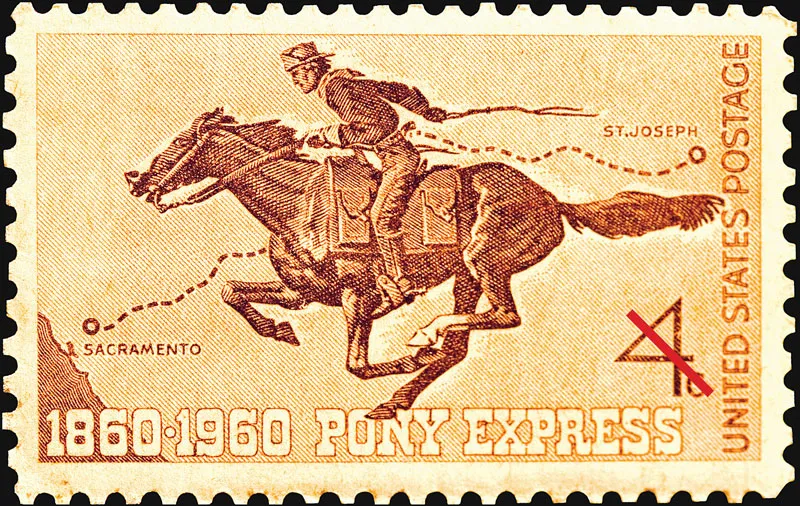
On April 3, 1860, at 5 p.m., a courier mounted a fast, spirited steed in St. Joseph, Missouri, and headed westward at breakneck speed. At about the same time in San Francisco, another rider began a dash toward the East. These were the first Pony Express riders.
During the eighteen months of the short history of the Pony Express, many miracles of endurance and bravery were performed before the famous relay system was replaced by the telegraph line. Racing from station to station, the average courier carried his precious cargo between 40 and 125 miles at a clip. Whether he rode over mountains or plains, or through dangerous Indian territories; whether his ride was at night or during the day, in stifling heat or cruel blizzards, the courageous riders of the Pony Express almost never failed to bring the mail to its destination. It is said that only one mail was lost in a total of 650,000 miles in the saddles.
Many of the express rides were products of the frontier, selected for their light weight and cool-headedness in times of danger. All were able to ride and shoot with amazing skill. Buffalo Bill Cody was, early in his career, a Pony Express rider.
From The Lone Ranger 96, June 1956
The Marriage of Don Ameche and Honore Prendergast
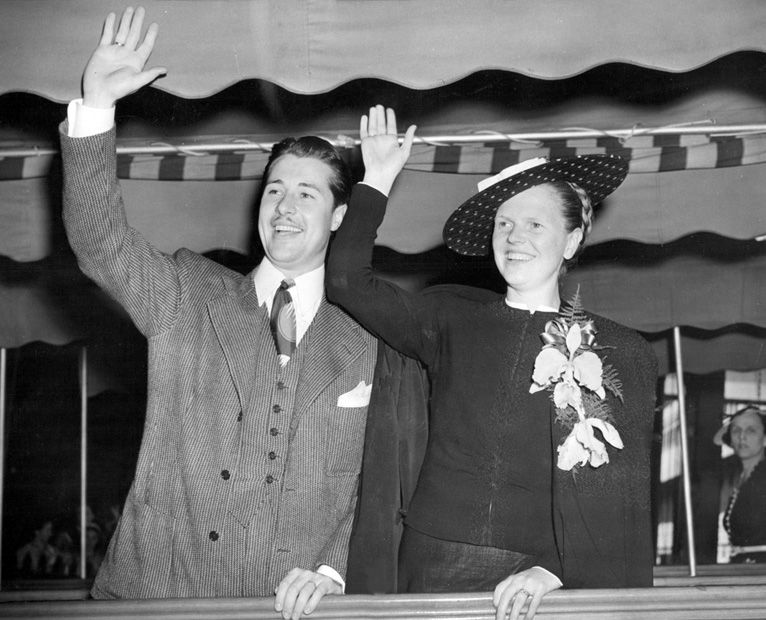
The debonair movie and radio star Don Ameche was only married once during his lifetime. He wed Honore Prendergast in 1932, they had six children and the union lasted until her death in 1986. That sounds like a storybook romance, but the following paragraph in her obituary from the Des Moines Register indicates it was a bit more complicated:
Don Ameche appeared in several radio productions, including a starring role in The First Nighter Program, in the 1930s. Among his most famous film roles was his portrayal of Alexander Graham Bell in The Story of Alexander Graham Bell. He recently won an Academy Award for best supporting actor for his role in Cocoon. His son, Don Jr., said his father is currently working on a film with Geraldine Page and Shelly Winters in New Jersey and will not be able to attend the funeral services.
Honore Prendergast Ameche died in 1986 at age 78 of a heart ailment in her hometown of Dubuque, Iowa. The Ameches had six children, 13 grandchildren and two great-grandchildren at the time of her death. During the height of Don's fame the Hollywood press listed their children as Donnie, Ronnie, Tommie, Lonnie, Bonnie and Connie. Her obituary lists her surviving children as Don Ameche Jr., Ron Ameche, Tom Ameche, Bonnie Steltenkamp and Connie Bringanti.
The Ameches both had ties to Dubuque, since she was born there and he had attended Columbia College, which is known today as Loras College. He was acting on the old-time radio show First Nighter in Chicago and she was residing in Dubuque the year they married. Modern Screen magazine asked Don how their romance began:
We went out together that night and ever night after that while she was in Chicago. Then she had to get back to her work. She was a dietitian in Dubuque. That was the first part of September. After that, every weekend, I covered the 170 miles to Dubuque to see her. In the last part of November, we were married. Father Sheehy came back from Washington to marry us.
The Ameches delayed their honeymoon for a year because he was so busy with his radio work, finally celebrating their union with a trip to Bermuda. Honore Prendergast was called the nickname Honey. She was separated from Don Ameche for the last 20 years of her life, according to Parade columnist Walter Scott.
Don Ameche died in 1993 at the Scottsdale, Arizona, home of his son. The cause of death was prostate cancer.
In 1979, entertainment writer Bob Herguth noted the length of the Ameches' marriage and asked Don for his secret of showbiz marital happiness. Ameche replied, "I wouldn't know."
Related Stories:
- Don Ameche's Lucky Break in 1930
- Four Radio Shows Hired Les Tremayne to Replace Don Ameche
- Jean Hersholt and Don Ameche Star in Sins of Man
The Big Story: An Interview with Bill Gagnon
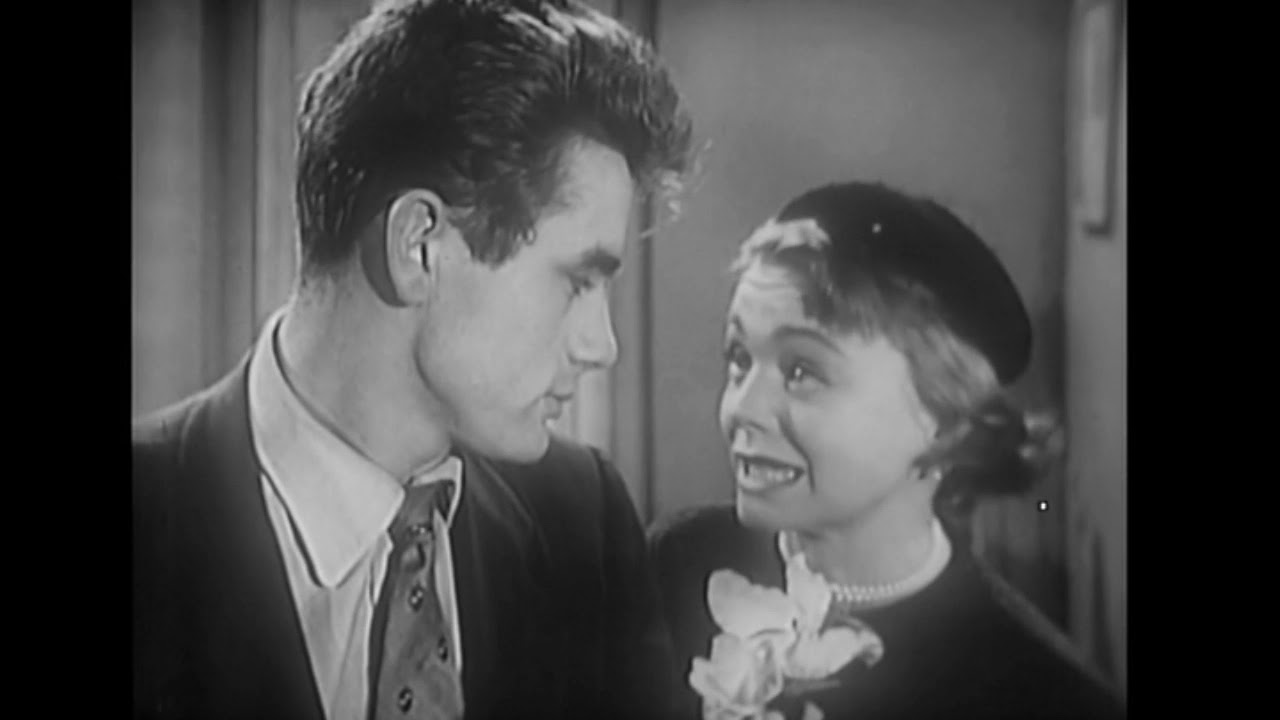
Some of the old radio shows were great, and some were only fair. Time plays funny tricks on our minds, however, and any show I actually recall listening to seems to come out in my mind as having been great. One such show was The Big Story.
The Big Story was likely one of those "fair" shows, and its Pall Mall cigarette commercials were probably more memorable than the show, but it is one of the shows that I remember and it is one of my favorites.
A popular radio personality, Ray Durkee of KHOW radio in Denver, currently has a show on Sunday from 10 a.m. to 2 p.m. called Sunday at the Memories. In his shows, Ray covers everything nostalgic, including records of the '40s and '50s, various old TV excerpts, bits from old movies and also sports-related items. Ray also includes a 30-minute old radio program, usually.
On Feb. 23, 1975, Ray ran "The Bill Gagnon Story," which was featured on The Big Story. At that time, he did a short telephone interview with Gardon. That interview follows verbatim:
Ray Durkee: During the golden days, the early days of radio when dramatizations in comedy and variety and that kind of thing were what we grew up with, there was a series called The Big Story. In The Big Story the whole idea of the show was to take various newspaper stories from people involved in the newspaper business around this country -- some of their stories -- and then dramatize them on radio. The fellow I'm going to talk with on the telephone, his name is Bill Gagnon, and Bill Gagnon has been involved in newspaper work I guess most of your life, haven't you, Bill?
Bill Gagnon: A good part of my adult life, Ray. I started back in about 1949 in Wichita, Kansas.
Durkee: And you've been a part of the Denver newspaper scene, working in the local newspapers. Right now Bill is associated with newspapers out of Pueblo, and in charge of the Denver office, right?
Gagnon: That's right. I work out of the State House, Ray, covering state government and federal government, and so forth. Matters of interest in Colorado.
Durkee: So when we talk about The Big Story, or your big story that was dramatized on radio, when did it happen?
Gagnon: Well, as best I can recall, it was about 1952, I believe, '51 or '52, somewhere in there.
Durkee: In Wichita?
Gagnon: Right.
Durkee: Okay, so that was really your first job as a newspaperman, wasn't it?
Gagnon: That's right. I was working for the old Wichita Beachon, which has since gone defunct and merged with the Wichita Eagle.
Durkee: That's pretty exciting considering it's your first job in the profession and you end up with a big story. Now briefly, can you tell us how the story went?
Gagnon: Well, it concerned a case in which a young woman's body was found in a duffel bag under the porch of her home, in East Wichita. What role I did have, I was quite disappointed in the way it did come out on The Big Story. In fact, in those days they would take the outline of a story and from what I could determine, apparently they threw it in the wastepaper basket and would write their own story.
Durkee: To make it palatable on the radio according to them.
Gagnon: Right. I was quite hot after I did hear it on the air and I wrote to them about it. Not to the advertisers themselves, but to an advertising agency that handled the account. And of course, they responded, and said that their job and the purpose of it was to glorify the reporter, so they took a little literary license there -- beefed it up the way they wanted it to sound.
Durkee: How did they change it?
Gagnon: Well, actually Ray, it's almost not recognizable -- the facts and the story. It's hard to separate fact from fiction there. It's mainly fiction. Later on, this radio series was bought by a television production company, and they put a series on the air in the early 1960s. Much to my amazement, I found out that I had a private secretary, a new car and the whole bit. This was back in the days when we made $50 a week.
Durkee: And you did a lot of hoofing, and you were lucky probably to even have a car.
Gagnon: Yes, as I recall I had an old Ford convertible with wooden doors, and the termites got to it. One door was half eaten away.
Durkee: Now in regard to the story as you covered it, how did they change it? The way the story comes out on the show is that it leaves the impression that he was a youngster who was involved in this, who kept bugging you and wanted to really find out what was going on, as far as the case. Is that what really happened?
Gagnon: No, that's not what happened.
Durkee: All right, what happened?
Gagnon: At the drugstore nearby the paper where we drank coffee frequently, I got some information from the girls working there who were related to the woman who was murdered. I did relay this information to the police. But actually as it came out on the air, gave very little credit to the police, and that was unfortunate because they did a tremendous job on this case. There was a detective by the name of Joe Kleppeth who broke the case, and I gave them this information. At the time Joe didn't think much of it, but the whole thing did gel together later on and did result in this young man being arrested. He was charged and later convicted, went to the penitentiary, and I understand he is a free man today.
Durkee: How long did he spend in the penitentiary? Do you know?
Gagnon: Something under, maybe about 10 years I would imagine.
Durkee: All right, did you have any contact at all with this fellow in question?
Gagnon: No.
Durkee: You never did?
Gagnon: I had no personal contact whatsoever, other than report and cover the story.
Durkee: That's amazing because the show makes it sound like he was bugging you. Well, I'm going to play the show, because that's amazing. In the show they leave the impression that here was a youngster that was really interested in newspaper work, and wanted to find out what was going on with this story, and he was constantly bugging you. But yet, you had no contact whatsoever with this fellow at all.
Gagnon: That's right.
Durkee: That's amazing. OK, I'm now going to play the show. Now people have heard from you how it really went, and your own true life, and we're going to see what radio did to it when they dramatized it, OK?
Gagnon: I'm sure they won't recognize a thing.
Ray Windix in Collector's Corner, October 1978
Charlie McCarthy and Mortimer Snerd Meet a New Generation
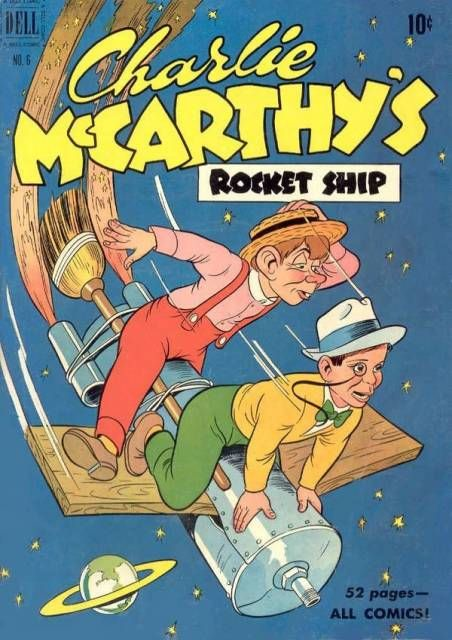
This past semester I've been teaching American humor to a group of 11th and 12th graders who have been brought up on Steve Martin, Bill Cosby, George Carlin and Richard Pryor. Sure, they've seen Bob Hope and Edgar Bergen and they remember Jack Benny and Groucho Marx. But Jack Carson? Judy Canova? Joe Penner? Fred Allen? Wasn't he the coach of the Red Sox?
Well, being a OTR freak,I had to set these kids straight on just who the best comedians of the 20th century were!
I played a Jack Benny show, a Jack Carson show, a Judy Canova show, a Fibber McGee and Molly and an Edgar Bergen-Charlie McCarthy show.
Here's what they had to say about these folks:
Cindy Brown, senior: "I really liked Edgar Bergen's Mortimer Snerd. I liked the line when he was at the carnival and he looked in a mirror in the funhouse and he thought he looked better than in real life."
Botsy Ross (no kiddin'), junior: I think Edgar Bergen was so successful because he gave the dummies personalities of their own. And it really sounded like there were two people talking instead of one. Charlie, Mortimer and Effie are real people. Effie was vivacious in that she loved men and everything to do with them."
Joyce Nutt, junior: Charlie gets hurt easily; he acts like a child, but he is lovable. He has a personality that makes you feel for him. I guess you could call Effie a 'dirty old lady.' She believes every man should be married whether he likes it or not."
Jim Nichols, senior: "Mortimer is not playing with a full deck! And Charlie -- people try to be nice to him, but he'd turn around and tell them to get lost. And for how old Effie is, she has a lot of spunk. I I also liked Fibber McGee and Molly because of the way they worked together as a team; they would crack each other up all the time."
Ted Williams (another no kiddin'), junior: Mortimer is a dumb dummy, but he's so dumb you have to laugh at him."
Dannette Hyer, junior: "Charlie is funny, but also brash. He says things that most people wouldn't say to others, but he thinks nothing of it."
You might have noted something among these comments -- most of them had to do with Edgar Bergen and his characters. Most of the class felt, of all the comedy shows I played for them, Charlie, Mortimer, and Effie were the best.
Probably Bergen's comedy did appeal to the teenagers of the '30s, '40s,and the '50s more than the others used in my classes. Maybe someone reading this may have access to a poll taken during the Golden Age that would either refute or agree with this assumption.
Anyway, Charlie, Mortimer and Effie will live forever as long as those of us in OTR can let others hear them once again.
From Illustrated Press, April 1980
Roy C. Knapp Followed the Beat of His Own Drum
![Ad for Roy C. Knapp School of Percussion that reads: The Cradle of Celebrated Drummers. School Students and Professionals. First chair in a high school band or orchestra, or a well-salaried position in a top-flight dance, radio, television, theater or concert orchestra -- no matter which you choose -- the Knapp School can help you attain your goal in the shortest length of time. The finest professional teaching staff in the country, coupled with over 20 years of instruction using the most modern, practical methods, assures you of the training necessary to reach your goal. The Knapp School specializes in all branches of percussion, piano, voice, theory and all orchestral instruments. Korea and World War II Vets write for information now! Roy C. Knapp School of Percussion, Ohio Bldg., 509 S. Wabash, Chicago 5, Ill. I am interested in [checkbox] GI Training, [checkbox] Private Lessons, [] Percussion, [checkbox] Accordion, [checkbox] Piano, [checkbox] Voice, [checkbox] Bass, [checkbox] Reeds, [checkbox] Brass, [checkbox] Guitar, [checkbox] Theory, [checkbox] Arranging. I am a vet of [checkbox] Korea, [checkbox] World War II. Please check!](https://winnetoba.com/media/roy-c-knapp-school-of-percussion-ad.png)
A series of accidents led Roy Knapp Into the life of a professional musician. Of course, Knapp had been reared in music. His father was a violinist, and from his earliest days Knapp was taught to play the violin. Then he broke his left arm in such a way that, even after it healed, it was impossible for him to finger the strings of the violin.
So he took up the trumpet. His father wanted Knapp to be a farmer, and several times Knapp was put on a farm to learn agriculture. But Knapp's real ambition was to become a professional baseball player and he spent most of his spare time in the sandlots slugging balls. Knapp says now that if he hadn't broken practically every bone In his body, he would never have given up his ambition to play ball.
After he graduated from high school, he learned the painting trade. Knapp's father had just opened the first motion picture theater in Waterloo. Iowa, their home town. During the day. Knapp was working as a painter and in the evenings he was playing his trumpet at the theater, running the movie reels by hand and making posters to advertise forthcoming attractions. For recreation he slept. He still wasn't considering music seriously as a career.
Then one evening the drummer in the theater orchestra became suddenly ill and was unable to play. It was up to Knapp to take over his job, and from then on Knapp began to take his music seriously.
His first symphony engagement was with the Minneapolis Symphony orchestra when it was directed by the late Emil Oberhoefer. Since that time Knapp has played with a number of symphony orchestras and at one time played with Victor Herbert, the famous composer.
Knapp came to WLS seven years ago and has been a regular member of the concert orchestra, as well as one of the Cornhuskers. He has played on more network shows than he can remember and is at present in the orchestras heard on the Contented Hour with Morgan Eastman, on the Northerners program, and in the Edison Symphony concerts. in addition to the NBC-WLS barn dance every Saturday night. He is also one of the red-coated members of Uncle Ezra's Silver Cornet band.
When Knapp plays in an orchestra, he is completely surrounded by musical instruments. He plays the traps, chimes, xylophone, vibraharp and tympani.
In his work at the NBC studios, Knapp has met many famous singers, including Nelson Eddy, Lawrence Tibbett and Ernestine Schumann-Heinck.
The last few years he has spent much of his time in teaching students the percussion instruments and he takes pride in the fact that many of his pupils are playing in the leading orchestras of the country.
To look at Knapp you'd never believe that he is a sentimentalist at heart. You'd have to look at his collection of pictures to believe that. He has old faded pictures of his sister and brother in baby clothes, a highly prized picture of his mother who died when he was only 8, old-fashioned pictures of the orchestras he has played in since he was a youngster, and a number of childhood pictures of his daughter, who is now 23, and his son, who is 17.
Then, too, Knapp likes animals -- horses, dogs. cats and even snakes, and has brown eyes and brown wavy hair that he tries to keep straightened out. He is 5-foot-8. His birthday is October 26. Tucky, Knapp's little Boston bull pup, is a frequent visitor to the studios and waits quietly in Knapp's office while he is on the air.
From Stand By, July 18, 1936
Related Stories:
Jack Benny: How Radio Made Comedy Grow Up
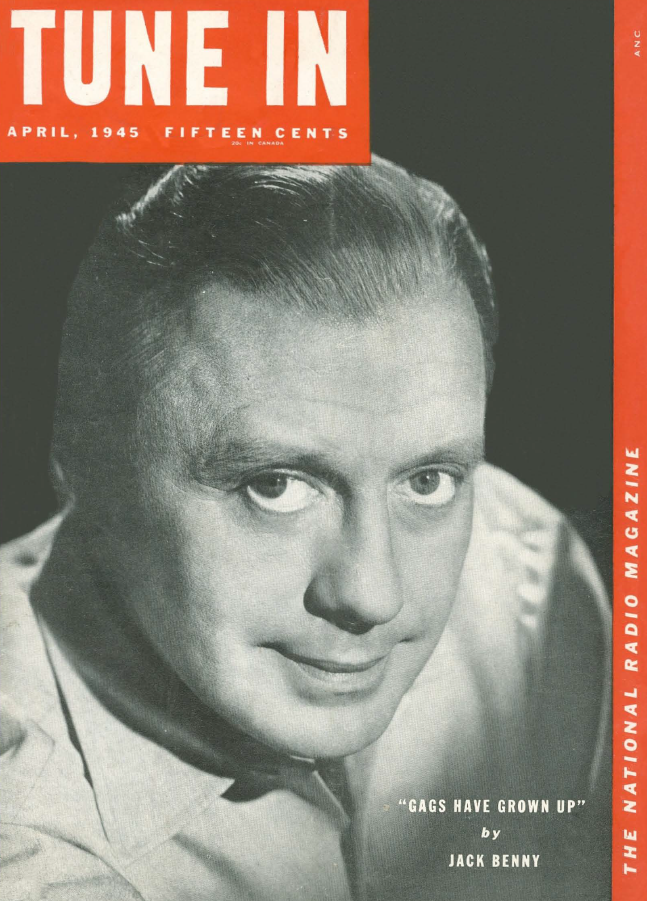
In the past 20 years, American humor -- accelerated by radio -- has come out of the barnyard. It has been cleaned up, perfumed and sparked by those unsung heroes, the gag writers. Today, the ether is so full of good gags that even the ghosts have hysterics.
I will go out on a limb to say that radio has done for American humor in 10 years what it would have taken vaudeville 50 years to reach. I feel no heartaches over vaudeville's passing, when I think of the way the old-time comic used to get his laughs. Gags were in their infancy then. They were as unsteady as a baby -- and had to be changed just as often. A comedian used to throw a gag at a vaudeville audience with a swing and a prayer, never knowing whether it would roll 'em in the aisle -- or roll up the joint. He might get howls with a certain gag at one show, and at the next the audience would look at him as though he had just read from page 26 of the Zanesville, Ohio, classified directory.
As a result, he desperately needed some sort of "gag insurance." He had to get laughs -- or else. His formula for this was pat. First, he pitched his opening gags across the footlights. If nothing happened, he tossed them his vary best gag, just to make sure that the audience was still there. Then -- if nothing but cigar smoke came back -- he played his trump card. A concealed tug at his belt, a deft wiggle ... and his pants fell down.
That was always sure for a laugh -- until, with dozens of comics doing the same thing all over the country, even this trick grew stale. So new tricks were added. I remember one comic who got thrown off the circuit because his underwear lit up and played "The Star-Spangled Banner."
Gags have grown up since then, and radio methods are quite different. Just contrast the old vaudeville routine for insuring gags with what we have today. Our gag insurance doesn't rely on slapstick but upon what we call a "topper." We then get a topper to top a topper -- and perhaps one to top that, as illustrated by the following dialogue used by Mary Livingstone and Rochester on our program:
Mary: You say you just got in town, Rochester. What took you so long ... was the train late?
Rochester: What train? I was out on Highway 99 freelancing.
Mary: You mean you hitchhiked. Why?
Rochester: Well, instead of a train ticket, Mr. Benny gave me a road map.
Mary: Oh.
Rochester: And a short talk on the generosity of the American tourist.
Mary: You mean that's all Mr. Benny gave you?
Rochester: No ... he also gave me a white glove for night operations.
There you have three toppers, all on the same gag. That's the kind of insurance that you, as a comedian, can feel safe with. It's like holding a ticket on every horse in the race. It's safer, more dignified -- and saves a lot of wear and tear on your pants.
Some people think that comedians and gag men are responsible for bringing American humor out of its giggly youth to manhood. While it would be nice to take the credit, our overtaxed consciences won't stand the strain. No, it's the audience who shoved the "little men" up to voting age.
The clamor for something better and still better has made necessary the same strides in gags as in automobiles and planes. When your gags and routines start lying around on the stage like old eggs from the same tired basket, and your audience reacts to your stuff as though they had lockjaw ... brother, you'd better start looking for better material -- or a rich widow!
The public today demands more of its humor than "a laugh at any price." It resents too much insulting, too much cynicism In short, the public likes good comedy, but it likes good taste even better. I have found that a gag line with too much sting is about as funny to people as a trial fitting for the electric chair.
You've probably noticed that nobody ever gets hurt on our program. Of course, I am subjected to quite a little shoving around -- I'm supposed to be a braggart, I'm supposed to wear a toupee, I'm supposed to be stingy -- but it's all in the spirit of fun! We try to follow one simple rule: "If it hurts, it isn't funny." (Naturally, however, I reserve the right to modify this, in the case of Fred Allen.)
Basically, our show is built on a foundation of real people -- not burlesque characters, but ordinary, everyday people. I'd be willing to bet that there are very few of you who don't know people exactly like Mary, Phil Harris and Rochester, as they are represented on our program. Yes, and there are lots of others who are just as dumb as Dennis Day was on our program (though I'm apparently having a tough time finding one dumb enough to work for the same money as he did.)
We feel that, to a certain extent, we represent the audience. In us, they see themselves. It would be foolish for us to knock each other around, because then we would be knocking the audience around ... and when you start doing that -- well, your sponsor had better be your own brother-in-law.
However, one of America's greatest national characteristics is our ability to laugh at ourselves. When the audience sees themselves through us, they get a special kick out of the jokes that seem to fit them personally. If someone pulls a gag on me about my having false teeth, 98 percent of those in our audience who have false teeth will laugh heartily. (The other two percent would laugh, too, but their gums are still sore.)
Throughout, we try to have things happen to us which would happen to anyone -- things which will be interesting and also, above all, funny. That's why so many of our routines and gags come from what we see around us -- like all that water, when we were coming from Vancouver to Seattle by boat.
We were all on the top deck enjoying the beautiful scenery ... all, that is, except Phil Harris. Harris was down in his stateroom asleep. He isn't very interested in water -- thinks there's too much of it to give it any value. I know this because, once when I was talking to Phil about the earth and how it was three-fourths covered with water, he said, "Yeah. You know, Jackson, I think the Creator slipped up a little there. He could have just as easy made it bourbon!"
Well, we were talking about all that water and started throwing a few ideas around, finally coming up with: "Harris was mad when he saw all that chaser with nothing to go with it." We weren't satisfied, but we knew we were on the track of something. We worked it over some more and then tried another version: "It made Harris mad to see all that water and nothing to break the trail." It still didn't have the snap it needed until my writers switched and changed it to: "Harris was mad when he saw all that chaser -- with nothing to break the trail."
That was it. Why, I don't know. But it was. It may sound like a simple idea and, on paper, look as though very few changes had been made, but the audience roared when we served it up on the program. If we'd tried that in vaudeville 20 years ago, without the split second timing that we use on the air today, it would only have died a quick death on the other side of the footlights. Perhaps audiences, too -- as well as gags -- have grown up.
Let me bow out with this piece of advice. Since you, the listener, are responsible for the present high level of our humor ... keep it that way. Don't let us comedians slip back into the "easy way." Keep writing those letters telling us what you like, what you don't like, and what you want. You're the boss and I'll get it for you -- even if I have to keep my writers up all night to do it!
Jack Benny in Tune In, April 1945
Nelson Selby, the Busiest Organist in Buffalo
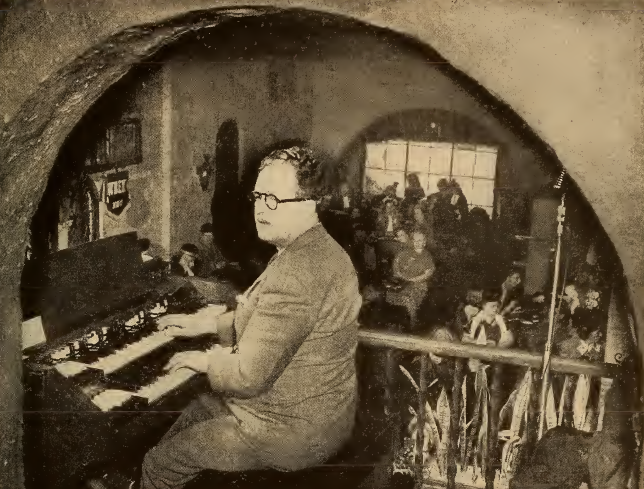
One rarely thinks of an organist as being a much-traveled man or one whose activities would run from virtually dawn to midnight. But WBEN organist Nelson Selby is currently providing the musical backbone of Breakfast at Laube's Old Spain five mornings a week, playing at the Hotel Lenox six evenings a week, and airing a Sunday afternoon organ program on WBEN. He also is heard frequently on Sundays at Buffalo's leading churches.
Selby can hardly remember the time when he wasn't in love with organ music. It started when he filled in as church organist on Sundays. After high school graduation he studied at the Eastman School of Music in Rochester and later attended the University of Buffalo. But it was long before that -- at the age of seven -- that he began his musical studies.
Curiously, Selby attracted early attention for his accordion playing as much as his artistry on the organ. Two decades ago he teamed with Mickey Sullivan, the leader of television's famous Mad Hatters band on WBEN-TV. As the Boys from Melody Lane, he and Sullivan broadcast from WGY, Schenectady and for two summers sang at famed Saratoga.
For his morning Breakfast programs Selby utilizes the Hammond organ at Laube's but on Sunday afternoon he plays the huge WBEN organ at the station's studios. At the Lenox Hotel he has his own equipment -- Hammond, celeste and chimes. He also is a consultant and salesman of Hammond organs at a local music house.
Selby has three children -- Dick, seventeen; Judith, eight and Diane, four. Dick is preparing for MIT.
From Radio and Television Mirror, July 1949
Top 10 Articles
- The Marriage of Don Ameche and Honore Prendergast
- The Night Arthur Godfrey Fired a Singer On Live Radio
- Early Radio Announcers Invented Their Profession in the 1920s
- The Mythical Town of East Tincup, Colorado
- The Earliest Radio Shows of the 1920s
- The Great Radio Detectives of the 1950s
- The Home Life of Jack Benny
- Why Vladimir Horowitz Stopped Performing in the 1930s
- Judy Canova: The Queen of Hillbilly Hokum
- Some of the Unsung Heroes of Radio

